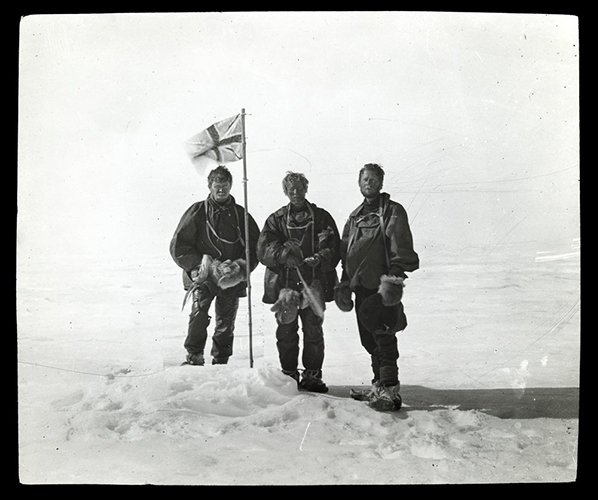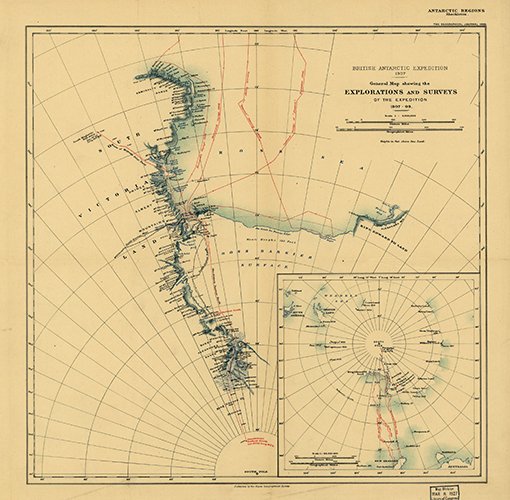On This Day: Australians first to reach South Magnetic Pole

ON THE AFTERNOON of 16 January 1909 three exhausted men trudged up to a spot on the Antarctic ice and planted a Union Jack in the snow. The explorers Douglas Mawson, T.W. Edgeworth David and Alistair Mackay had reached the vicinity of the South Magnetic Pole. They had hauled sledges across a formidable icescape, covering a distance equivalent to the drive from Sydney to Cairns in one of the harshest environments on earth.
As the flag fluttered in a light breeze, David claimed the pole and its surrounding land on behalf of the British Empire. The trio knew they weren’t at the exact spot – their compass still fluttered in the direction of north west – but they were close enough. It would have taken a month of magnetic observations to pinpoint the pole, and these weary men didn’t have time to spare.
The subdued party gave three cheers for the King. They took a photo to commemorate the historic moment, and then, as David wrote, “…we all did a right-about turn and as quick a march as tired limbs would allow back in the direction of our little green tent in the wilderness of snow”.

Alistair Mackay, T.W. Edgeworth David and Douglas Mawson (L-R) take a grim selfie at the South Magnetic Pole after an arduous trek in Antarctica.(Credit: State Library of South Australia/H90.31/35)
In search of the South Magnetic Pole
Mawson, David and Mackay were members of the Nimrod Expedition, led by Ernest Shackleton. David, professor of geology at the University of Sydney, was employed as the expedition’s chief scientist. Mawson was a lecturer in mineralogy at the University of Adelaide and a former student of David’s. He was excited by the scientific opportunities of the expedition, and convinced Shackleton to bring him along as a physicist. Mackay hailed from Scotland and was the expedition’s doctor.
While Shackleton and his team attempted to reach the geographic South Pole – the southernmost point on Earth – Mawson, David and Mackay headed north-west. Using a special type of compass, called a dip compass, their goal was to determine the location of the South Magnetic Pole. The North and South Magnetic Poles are the points that a compass needle points towards, rather than true north or south. It’s very close to true north or south, but is determined by the Earth’s magnetic field rather than geographic location.
Reaching this elusive point would bring the men public recognition and, more importantly, scientific prestige. “Mawson was first and foremost a scientist,” says Peter FitzSimons, author of Mawson and the Ice Men of the Heroic Age, “He was in it to expand the frontiers of knowledge, rather than the more superficial glory of planting flags where no one had been before.”
Mapping magnetism in Antarctica was important for understanding Earth and its geology. Unlike the geographic South Pole, the magnetic South Pole is not a fixed point. It wanders over the surface of the Earth as the magnetic field surrounding our planet fluctuates. “Even on a daily basis, the magnetic South Pole moves,” says Antarctic adventurer Tim Jarvis. “To get within a couple of kilometres of the magnetic South Pole, even today with modern instrumentation, is deemed to be about as close as one can get to reaching it.”
Today, the South Magnetic Pole is located off the coast of Antarctica, some 2860km away from the geographic South Pole, and it is moving north-west by 10–15km every year. But back in 1909, it was still accessible over land.
Mawson’s Antarctic legacy
Despite reaching their goal, the men weren’t outwardly jubilant. “I think they felt euphoric,” says Peter. “Or at least as euphoric as Mawson ever allowed himself to be. He was not a man given to high emotion… but it was a huge scientific achievement.” After more than three months of gruelling travel, they were exhausted and hungry. Now, they faced a daunting deadline: if they did not reach the coast by the beginning of February, they would miss their ride home. They had to traverse 430km in just 16 days.
Luckily, they did make it to the coast in time to be picked up by the Nimrod – but not without difficulty. After battling bad weather, coping with David’s ailing mental health, and rescuing Mawson from the bottom of a crevasse, the explorers were finally safe aboard the boat on 4 February.
The legacy of this intrepid journey is significant. Along the trek, Mawson charted the coastline, discovered several new peaks and glaciers, and kept detailed magnetic and geological records. The trip also extended the realm of human possibility. It tested the limits of physical and mental endurance and remained the longest unsupported sled journey until the 1980s.
Despite being overshadowed by Shackleton’s near-success in reaching the geographic South Pole, the journey typified the pioneering feats of the Heroic Age of Antarctic Exploration. “I think it is a lesson in overcoming adversity and in amazing leadership,” says Tim, “The journey saw leadership of the team shift from David to the younger Mawson and was a sign of greater things to come from him.”
Indeed the expedition acted as a stepping stone of sorts for Mawson. “He realised his own competence,” says Peter. “It gave him confidence and ambition. He realised he could organise his own expedition and began forming up a mental list of what he’d need.”

Shackleton’s map detailing the course of the Nimrod Expedition to Antarctica.(Credit:Library of Congress)
READ MORE:
-
On Mawson’s 1911 Antarctica expedition, Moreton Moyes endured the longest-ever solo Antarctic stint
-
GALLERY: Surviving Mawson’s 1911 expedition
-
GALLERY: historic images Mawson’s hut in Antarctica




